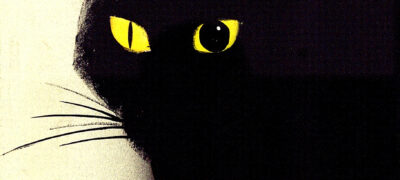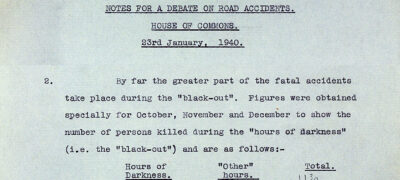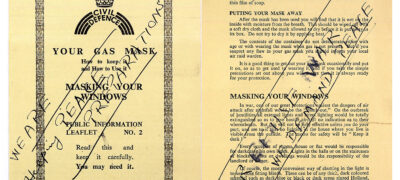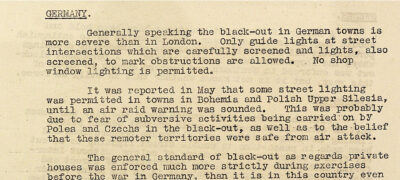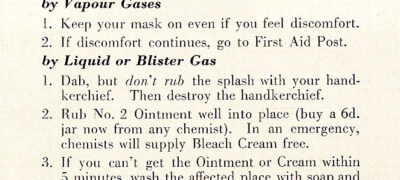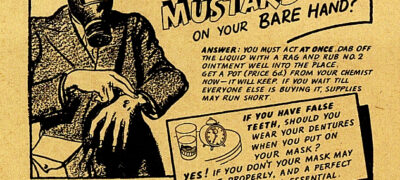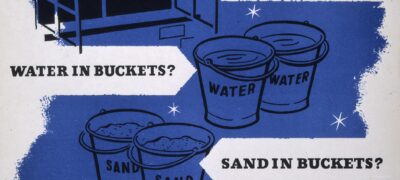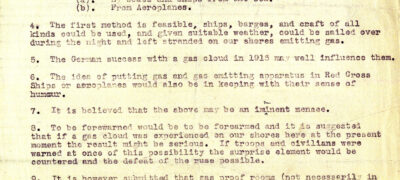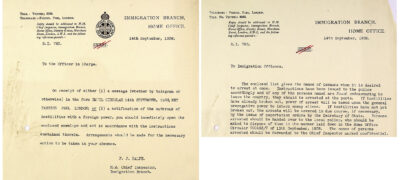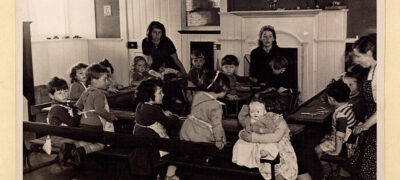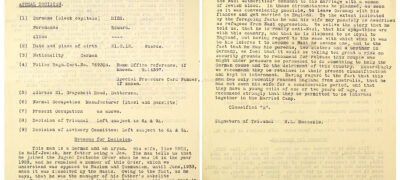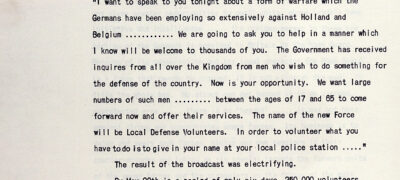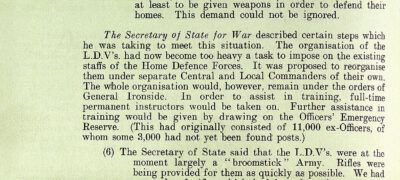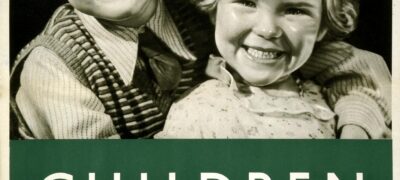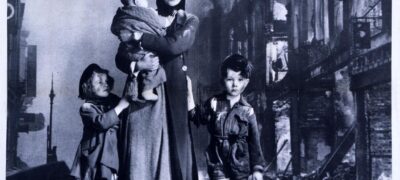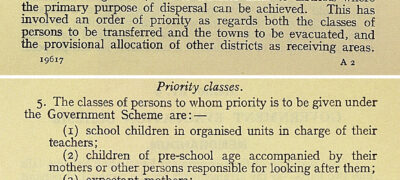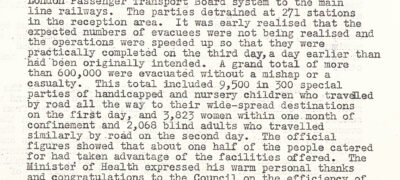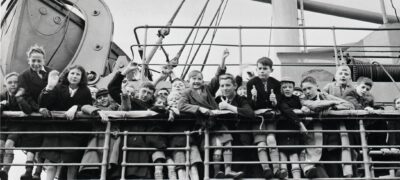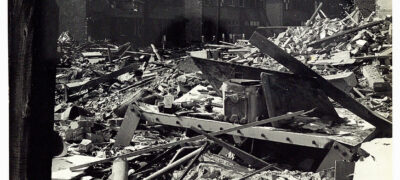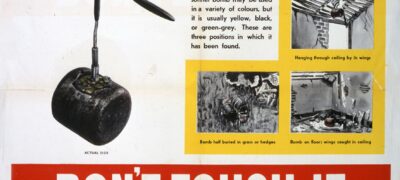Download documents and transcripts
Teachers' notes
The purpose of this document collection is to allow students and teachers to develop their own questions and lines of historical enquiry on the political and social aspects of the Home Front, 1939-1945. The documents themselves are arranged according to theme, so that sources are grouped together rather than following a strict chronological order.
To accompany both collections of documents, we have linked to a collection of original films from the Imperial War Museum about life on the Home Front. We provide questions on these films and there is also a task outlined below:
Watch a film and discuss/answer the questions:
- Select 3 to 5 documents from either Home Front collection to show how they can be used to support the message and content of one or more of the films.
- Write a report/record a video to explain your choice of documents.
- What are the advantages of using public information films like these with document sources as evidence for life on the Home Front?
There are four themes covered in this collection (Part 1) .We have provided questions/tasks for some of the sources in each theme. Please note that there are not questions for every source, except for those indicated in these notes. Some questions however link to other referenced sources in the collection for learners to explore at the same time. The questions can also be found on the relevant source pages for convenience with additional notes to provide context.
1. Preparations for war: blackouts; gas raids and masks; internment; the Home Guard.
Poster: Warning about the dangers of the Blackout, 1939 Catalogue ref: INF 3/290
- What was the blackout?
- How does the poster use language and image to persuade people to be careful in the blackout?
- Why do think the government produced the poster?
- What is the connection between the poster and the notes for a debate in the House of Commons on blackout accidents, January 1940, Catalogue ref: MT 55/296?
- Can you find a source which shows some people objected to the blackout?
- Why do you think the government kept a complaint about the blackout on file?
Gas Raid quiz to be placed in newspapers by the government, 1941 Catalogue ref: HO 186/2247
- Why do you think this ‘Gas Quiz’ was placed in newspapers?
- Do you think it is more or less effective than the instructions for what to do in a gas attack printed in Sunday newspapers, May 1941? Catalogue ref: HO 186/2247
- Can you find a document which explains why the government wanted to prepare the country for potential gas attacks?
Document: Instructions about internees in the event of war, 1938, Catalogue ref: HO 144/21256
- What were immigration officers told to do concerning Germans living in Britain if war was declared?
- Why did the government make these plans?
- Read the appeal for Eduard Ries. Why was he interned? Do you think the panel was correct to continue his detention? See the appeal document: Catalogue ref: HO 214/26?
Document: Cabinet report on the forming of the British Home Guard, Catalogue ref: CAB 106/1189
- What was the Home Guard?
- How and when did the government form the Home Guard?
- Why do you think that the government found radio broadcasting so effective during wartime?
- Why do you think so many people wanted to be in the Home Guard?
- Why were there problems in supplying guns to the Home Guard according to this document: Catalogue ref: CAB 65/7/170)
- Do you think the Home Guard had a value other than defending Britain?
2. Evacuation of children
- Why did the British government want city children to leave their homes in 1939?
Document: London County Council Study of Evacuation 1940, Catalogue ref: ED 138/49
- How was evacuation organised?
- What problems emerged with evacuation by 1940?
Poster: Children are safer in the country, Catalogue ref: INF 13/171
- Why do you think the government produced this poster?
- How does the poster use language and image to persuade people to evacuate their children?
Photograph: CORB children to New Zealand, 1940-1, Catalogue ref: DO 131/15
- Find out more about the Children’s Overseas Reception Board set up to evacuate children abroad.
Poster: Caring for evacuees, Catalogue ref: INF 13/171/7
- How does the poster use language and image to persuade women to volunteer and help in child evacuation?
- How does the poster try to ‘persuade’ families to support evacuation?
3. The Blitz: air raid precautions, shelters, Bethnal Green tube shelter disaster.
German Air Attacks on England, 8 August 1940 – 10 September 1940 (AIR 2/7355)
- Where were German attacks made in the first phase of the Blitz or bombing campaign against Britain?
- Which British cities were to be attacked as part of the ‘Moonlight Sonata’ German bombing campaign? Catalogue ref: AIR 2/5238
- What were the aims of the British counter plan called ‘Cold Water’. Can you guess why it was called this? Catalogue ref: AIR 2/5238
- Take a look at the photograph showing bomb damage Catalogue ref: HO 197/28. How could photographs like this be used to persuade people to use public shelters?
- What does this photograph reveal about the nature of bombing raids?
Diagram: ‘How to put up your Morrison Shelter’, Catalogue ref: HO 186/580
- Can you explain how the Morrison shelter worked?
- Compare this to the Anderson shelter ‘Diagram of how to construct an Anderson Shelter’, Catalogue ref: ZPER 34/196).
- According to Jenny Fleming in her letter addressed to Herbert Morrison what were the problems of public shelters, 1940? Catalogue ref: HO 207/783
- Do you think Herbert Morrison would have responded to this letter?
- Could the government have done anything to improve public shelters?
Document extracts: the Bethnal Green Tube Shelter Disaster Inquiry Report, Catalogue ref: CAB 66/35
- What were the main conclusions in the report about the causes of this Bethnal Green tube disaster?
- Why do you think this document is titled ‘Most Secret’ to be kept under lock and key?
- Why did the War Cabinet decide not to publish the full findings about the Bethnal Green Tube Shelter disaster, Catalogue ref: CAB 65/34
- What did they fear would happen if the Germans found out about it?
- What statement did they make in the House of Commons about the disaster?
4. The Empire Home Front
Photographs: Women at work in the Empire, Catalogue ref: CO 875/15/12
- What does this source reveal about the contribution of the British Empire to the war effort?
- What raw materials did Britain use from the empire during the Second World War, see Diagram: Catalogue ref: CO 875/15/12/f46
- How did Indian men support the Home front? See Poster: On War Work in Britain, Catalogue ref: INF 2/11 (5)
- How did Indian women contribute in civil defence? See Poster: On War Work in Britain Catalogue ref: INF 2/11 (3)
- Look at the diagram showing local defence forces within the British Empire. What does this document reveal about the role of local defences in the Second World War? Catalogue ref: CO 875/15/12/f34
Students could work with a group of sources or source type on a certain theme or linked themes. The documents should offer them a chance to develop their powers of evaluation and analysis and support their course work. Alternatively, teachers may wish to use the collection to develop their own resources or encourage students to ‘curate’ their own ‘exhibition’ of the most significant sources on the topic.
Please note that content in this themed collection has been redeveloped from content in our Home Front 1939-1945 focussed topic website which has been archived as the interactive parts no longer work.
Connections to curriculum
Key stage 4
Edexcel GCSE History
C 1900– present: Warfare and British society in the modern era
Experience of war: The impact of war on civilians, including recruitment and the organisation of a Home Front during Second World Wars. Government use of censorship and propaganda in wartime.
The historic environment: London and the Second World War, 1939–45
OCR GCSE History
The First and Second World Wars: the beginnings of ‘total war’, including the impact on people’s lives, increased state power and the changing relationship between the state and the people.
Key stage 5
AQA GCE History
The People’s War and Peace, 1939–1951
The social and cultural impact of ‘total’ war: conscription; women and children; civil liberties and restrictions; propaganda; the Blitz; plans for reconstruction including Beveridge and the Butler Act; policies of post-war Labour government, including the creation of the NHS and medical advances
Introduction
Home Front 1939-1945: Fighting the war at home.
The Second World War has justifiably earned the name a ‘People’s War’ as it involved citizens not just the military.
As soon as war was declared on 3 September, 1939 the British government’s first priority was to ‘get the children away’ from industrial areas, overcrowded cities and anywhere that was expected to be among the first targets for German air raids.
Local authorities implemented the plan at once. Mothers could take babies and young children with them, while school age children assembled in their school playgrounds to be marched to the nearest train station accompanied by teachers and volunteers. Children had a luggage label pinned to their coats with their names and destination. On arrival in rural areas – deemed safer from air raids – the children piled out and were met by a crowd of locals who had agreed with the billeting officer to take in evacuees. They walked around picking which child they wanted to take home: pretty little girls were soon chosen while farmers were on the look-out for strong lads to help with the harvest – one child recalled it being like a cattle market.
Evacuation was never compulsory so it presented a dilemma for parents: Should they send their children away to live with strangers for an undetermined length of time, or keep them at home where they might be killed in an air raid? Some children enjoyed being away from home – with space to kick a ball and explore the countryside – while some cried themselves to sleep every night.
When people were asked what they hated most about the war, for most it was the blackout. The government thinking that German technology was more advanced than it in fact was, ordered that no light that might attract attention from the German bombers must show. The blackout lasted from sunset to dawn. During those hours, shops, factories and office buildings had to turn off their lights – while householders were told to use special black out material to replace their curtains, but that was expensive and shops soon sold out. A cheaper option was to paint windows black or, as a last resort, to nail cardboard to the window frames.
Policemen and volunteer Air Raid Protection (ARP) officers would patrol city streets to ensure that regulations were being observed to the letter. If they detected a sliver of light coming from a house, they seemed to rather enjoy bellowing ‘Put that light out!’ Transgressors were likely to be fined up to two pounds for a first offence or up to £50 pounds if you were a repeat offender.
People found it possible to cook by candlelight but reading a book, knitting, attempting to do a jigsaw or tackling a crossword puzzle was impossible. If it was depressing to be indoors, it was hazardous to venture out as street lights had been dimmed, and even if you could buy the batteries for a torch the beam could only be directed at the ground. People bumped into each other, into pillar boxes or walls. Some were so disoriented that they were unable to find their own front door. And you took your life in your hands if you tried to cross the road as car head lights were dimmed, or covered with a sock.
All that summer what George Orwell described as ‘nuisance raids’ during the day became a regular occurrence, but on 7th September 1940 the war took an ominous turn with the first of 57 consecutive nights of bombing and the start of the ‘Blitz’. When the air raid warning sounded at 8 pm and people took shelter in either Anderson shelters, which were provided by the government and free to most of the population who had their own garden. It was not until nearly the end of the war that Morrison shelters were used. These were heavy iron constructions which sheltered people without an outdoor space.
London docks and warehouses were demolished by the bombing. Firemen struggled for days to extinguish the flames, whilst many commodities, like sugar, burned furiously. The people had little choice but to take refuge nightly in underground stations, yet the casualties remained high, with the air raids killing over 43,000 civilians, and seriously wounding 139,000 more.
Britain, however was not the only country to suffer from bombing raids and the threat of invasion during the Second World War. Countries in Britain’s overseas empire came under attack, for example Malta and Australia. As well as making a massive contribution to the allied army and providing resources, the colonial empire protected itself at home with local defence forces and other organisations such as Air Raid Precautions units.
Juliet Gardiner, author: ‘The Thirties’; ‘Wartime Britain’; ‘Joining the Dots: A Woman in Her Time’.
External links
- For further sources search the collections at the Imperial War Museum
- Find a wealth of visual material on the Art of War
- Find out more about life on the Home front from National Museum of Scotland
- National Archives blog on civilian honours during Second World War
- National Archives blog on the Home Guard
- National Archives blog on women in Second World War art
- National Archives blog on the Beveridge Report 1942 and foundation of the Welfare state
